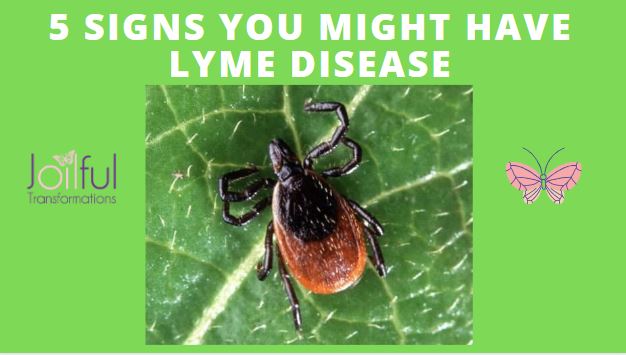
It is hard to imagine that an insect about the size of a poppy seed could disable a person to the extent of becoming bedridden!
As I write this article, a dear friend of mine remains nearly bedridden after THREE years of dealing with Lyme’s Disease! What is Lyme’s Disease? What are some tell-tale signs that you might have Lyme’s Disease? What are the treatments for Lyme’s Disease, and what complications can come from that treatment? Are there ways to use natural solutions to reduce the threat of getting Lyme’s Disease? These are the topics that will be addressed in this article.
There are more than 300,000 cases of Lyme’s Disease reported each year in the United States alone. If caught early, this primarily tick-born disease, and the co-infections that often come with it, can be successfully treated with antibiotics. However, if not treated quickly, it can begin a devastating degeneration in the body and wreak havoc on a person’s health.
In an article by David Stewart, PhD., he wrote: “Lyme’s Disease is called “The Great Imitator” because its symptoms are often misdiagnosed as something else such as Fibromyalgia, Arthritis, Abnormal Heart Conditions, Attention Deficit Disorder (ADD), Chronic Fatigue Syndrome, Alzheimer’s disease, Obsessive Compulsive Disorder (OCD), Depression, Multiple Sclerosis (MS), Schizophrenia, and more. It has been estimated that only 10% of Lyme patients have been accurately diagnosed.”
What are some signs to look for to be alert to the presence of Lyme’s Disease? We’ll look at 5 signs that you could have Lyme Disease. This list is NOT exhaustive as people may present with many different symptoms, but this is a good place to start:
- A Bulls-Eye Rash – This is most common tell-tale sign that you may have Lyme’s Disease. The problem is that a majority of people never see a rash, or even know that they have been bitten by a tick! If you see a deer tick surrounded by a red rash that looks like a ring or a “bulls-eye,” it is wise to get to a doctor immediately. Because Lyme’s Disease is a very serious thing if left untreated, doctors will usually prescribe a round of antibiotics, which is usually a successful treatment.
- Joint Pain – Joint pain can be caused by many different things, but a majority of people who suffer with Lyme’s Disease have had a lot of joint pain. This pain, usually located in knees, shoulders, and wrists, can also be accompanied by swelling and stiffness.
- Swelling in the Lymph Nodes – People with Lyme’s Disease may notice swelling in the Lymph Nodes in their neck. This swelling could easily be misconstrued for having a cold or sickness. The role of the Lymphatic System is the clean out unwanted toxins. If Lyme’s Disease is beginning to affect the ability of the Lymphatic System to clean out these toxins, the Lymph nodes will begin to swell. This could be likened to plumbing backing up. If you notice swollen Lymph nodes and have no other symptoms of illness, it would be wise to get checked by a doctor.
- Extreme Fatigue – When your body is fighting Lyme’s Disease and possible co-infections, it can completely drain the body, leaving it exhausted and fatigued. There can be many reasons for fatigue, but if it continues, and you have no energy, even after a good night’s sleep, you might consider having a doctor check you for Lyme’s Disease.
- Flu-Like Symptoms – Many people with Lyme’s Disease experience flu-like symptoms: fever, achiness, fatigue, lethargy, chills, and headache. If you have these symptoms and they do not go away, it is advisable to get checked for Lyme’s Disease.
Antibiotics are the main treatment given for someone who has been diagnosed with Lyme’s Disease. Some doctors will prescribe a round of antibiotics even if a blood test for Lyme’s comes back negative. Sadly, more than 52% of people with Lyme’s Disease actually tested negative, depending on the test!
While it is important to be treated with antibiotics for Lyme’s Disease treatment, that can present a complication in a person’s health. While a proper dose of antibiotics will successfully kill off the Lyme’s Disease and any possible co-infections, it is also killing off the good bacteria in the gut’s microbiome. When the gut bacteria is balanced at 80/20 (80% good/20% bad), a person’s immune system can function at an optimal capacity. However, after just one round of antibiotics, a person’s microbiome can be severely imbalanced, weakening the immune system and opening them up to many other health problems. When the immune system is compromised, the body’s first line of defense is disabled, and the doors to other health issues is now opened. In addition, antibiotics have been found to cause inflammation in the gut lining, leading to intestinal permeability, or leaky gut.
Because of that, it is IMPERATIVE to heal the gut and repopulate the good bacteria and regain a proper balance in the microbiome. Drinking kefir, kombucha, bone broth, eating fermented foods, and taking a therapeutic probiotic and supplements are all excellent ways to repopulate the good bacteria in the gut. You can learn more about how to heal the gut by contacting me.
While treating Lyme’s Disease is absolutely necessary, it is also important to do everything possible to prevent getting this disease. There are many bug and tick sprays available, but they come with a heavy toxic and chemical load. There ARE natural products that can help to protect us when we are out in nature and help to keep us from getting bitten. Essential Oils are being found to be very successful in the prevention of bug and tick bites. Some of the recommended oils to use are clove oil, oregano oil, and vetiver oil. I always use an outdoor blend, which combines many wonderful oils that are very effective at keeping bugs and ticks away. Mixing these oils in a bottle with water and spraying on your skin and clothes is a safe and effective prevention against outdoor threats. It also comes with peace of mind that you are not adding to the toxic load by putting chemicals on your skin.
Even when we do everything we can to protect ourselves, sometimes things still do happen. If you find that you have Lyme’s Disease, it is very important to follow your doctor’s instructions for treatment. Using essential oils to support the body in the healing process can also be a valuable tool. Frankincense, OnGuard (a protective blend), and Oregano are all excellent oils to help support the body’s healing processes. These oils can all be taken internally, diffused aromatically, and used topically. (Oregano should be diluted with a good quality carrier oil topically) During the treatment and healing of Lyme’s Disease, following an anti-inflammatory diet, reducing stress, getting a lot of sleep, supporting the body with quality supplementation and essential oils, and being proactive in healing the gut are all important things to aid the body in the healing process.
Resources:
http://www.rmhealthy.com/LymeDisease
http://www.webmd.com/rheumatoid-arthritis/arthritis-lyme-disease
https://www.lymedisease.org/lyme-basics/lyme-disease/diagnosis/
http://www.raindroptraining.com/messenger/v10n3.html
https://hub.jhu.edu/2018/12/04/lyme-disease-treatment-essential-oils/

Recent Comments